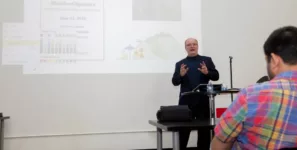The challenge for many tech companies is how to win the hearts and minds of the “Mainstream Majority” of customers. This broader market of users is tough to gain initial adoption from – but massive in number – since it represents 88-90% of addressable customers. Mainstream customers are not only a large set of potential buyers – they are also a powerful referencing group – as they will actively refer one another to a proven product they believe in, further increasing sales and adoption with even more virality.
In contrast, reaching the Early Market – typically only 8-11% of all customers – is much easier to gain initial traction with. Why? Because this group is much more comfortable with risk and will therefore move at a faster rate to buy new innovations – even if it is not yet close to being a 100% whole product.
Whether you work in cloud software, AI, electric cars, big data, or biopharmaceuticals, accelerating a product beyond the early stages of adoption is a major challenge, one that requires a serious understanding of adoption life cycles – i.e. to understand why some customers will embrace a breakthrough product or service, while many others will reject or ignore it.
Understanding the Six Key Life Cycle Stages
The first stage of customers in the adoption life cycle are the Tech Enthusiasts, who see the potential for the innovation, while still debating its best application. Next are the Visionaries, where more customers become enthusiastic about the product and are looking deeper at its feasibility and use. Visionary customers want to stay ahead of the competition by aligning with the perceived “next big wave.”
The next step in the life cycle is what we refer to in our numerous books as the “Chasm”, the rift between the early adopters – and the pragmatist customers in the “Bowling Alley”. At Chasm Institute, much of our client work – with over 500 tech companies in Silicon Valley and beyond – revolves around helping executives and product teams hurdle the chasm into greater market adoption and profitability.
Crossing the Chasm brings us to the “Bowling Alley” comprised of pragmatist users, followed by the appropriately named “Tornado” of mass adoption where we see accelerated growth rates, frenetic expansion, and strong customer word-of-mouth. Eventually a product or service may reach “Main Street” where growth slows, but overall usage increases even further until the market is saturated. At some point in what we call Mid-Main Street, repeat customers will outpace new first-time buyers. The tail end of the adoption cycle brings us to “End of Life” where the tech product or service is now replaced by a more disruptive / more innovative offering at the beginning of its “life.”
This six-stage pattern of adoption is remarkably predictable, whether the innovation is in the aforementioned cloud software, AI, electric cars, big data, or biopharmaceuticals. Note that categories representing Google Glass, the Apple Watch, and hydrogen fuel cell-based consumer autos have not yet crossed the chasm. And it took the category of artificial intelligence 27 years to cross!
Making the Leap
To assess if your product is truly ready to cross the chasm, consider 3 key factors that predict whether a product or service is too disruptive (i.e. it’s “too early”) to be bought and used by pragmatic customers on the right-hand side of the chasm:
- Is there a change in behavior or mindset required by the customer – in order to buy or use this product?
- Is there a change in skill required by the customer?
- Is there a change in process required by the customer – could be in buying, installing, integrating, or using the product?
If the answer is a resounding “yes” to at least two of these three questions, then getting across the chasm will be a protracted and possibly frustrating affair. Think way back to the Apple Newton MessagePad 2100 in 1993, or early smartphones from 1996 (Nokia Communicator 9000). But recent examples from the past 5 years are also instructive – Big Data, IoT, Augmented Reality, and, of course, AI (Artificial Intelligence). None of these categories had an easy time getting to the mainstream market. And some of them are still struggling indeed — despite massive early market enthusiasm, industry conferences, and spirited online discussions.
Consider an automotive industry example. If a new model year of a Toyota, Ford or GM vehicle can now claim 30mpg – up from 25mpg — then it’s clearly not a disruptive breakthrough. It might drive more unit sales and it’s certainly environmentally admirable, but the increase in efficiency is not a game changer. If the car improved from say, 25mpg to 85mpg, then it’s an entirely different story, as there would likely be a required shift in technology and a complete transformation of how drivers would perceive the car. That would be a disruptive innovation.
A tech industry example is the move from voice-only cell phones to smartphones, a massive breakthrough that allowed customers to gain dramatic new benefits and advantages. Smartphones crossed the chasm by dominating the “mobile professional / road warrior” segment – not with Mom and Dad and the kids (that came later).
It is worth noting that the companies that are first to market with a new innovation are not always the ones that prosper later (remember the first smartphone referred to above – the Nokia Communicator 9000). Ouch.
The key point here is this: with tech products it’s often not the “First Mover” that wins, but the “First Prover” – that is, the company that’s first at delivering a proven 100% Whole Product – robust, reliable, a “safe buy” – to the mainstream market. In B2C, think Apple in consumer smartphones, and in B2B, think AWS, Amazon’s amazingly successful cloud-computing-based platform for hosted storage.
Mapping the Development Model
For product managers, it’s vital to understand how these market dynamics and customer adoption patterns can drive real success – or real frustration and failure. Product managers and product teams need to have a clear understanding about WHERE their product category is on the adoption life cycle model. For example, disruptive innovations always launch into the Early Market, while more continuous innovations have permission (from customers) to go directly to the mature Main Street market. By the way: you don’t get a vote – i.e. the market decides where the category goes – not you.
An important caution for marketing managers with worldwide responsibilities is to understand that the adoption life cycle is not always the same from one region or country to the next. For example, consumers in Japan were using digital cameras well before markets in other parts of the world. Indeed, Japan is legendary for being early adopters for consumer electronics. Compare this dynamic to countries such as Germany or the UK, where “pragmatists” represent a larger group, so there’s more work to be done to get through the chasm in those countries.
Once you’ve assessed that your product needs to cross the chasm – you aren’t done yet. There are 9 key actions required to cross successfully – these are tough but essential:
- Target a specific customer segment
- Identify a major compelling reason to buy – i.e. solve a real customer pain point
- Build a 100% whole product
- Find the right motivated partners
- Develop a smart sales strategy that will drive adoption
- Set effective price points
- Review and adjust to competitor’s offerings
- Message and position at the specific segment you are targeting
- Later — Move to the next target segment to accelerate momentum
Getting the details right for these nine points is crucial. The good news is that doing this properly will provide you with something you need anyway – a strategy. Versus a hope, a dream, or a fantasy.
Development of a realistic and winning nine-point Strategy must always preceed execution. These nine points, when looked at wholistically, are a “reality check” that can provide you with a clear and unbiased look at the product and its probability for successfully crossing the chasm.
When these frameworks are use correctly, product executives and teams are better able to identify buyer behaviors – and dynamically adjust product / market strategy to accelerate through the various stages of the Technology Adoption Life Cycle.
Here’s wishing you all the best as you navigate through these challenging steps!
————————
As always, your thoughts, comments, and yes, counterpoints, are welcome.
Contact me at the LinkedIn link below:
Michael Eckhardt
Managing Director & Senior Workshop Leader at Chasm Institute — Silicon Valley Office








